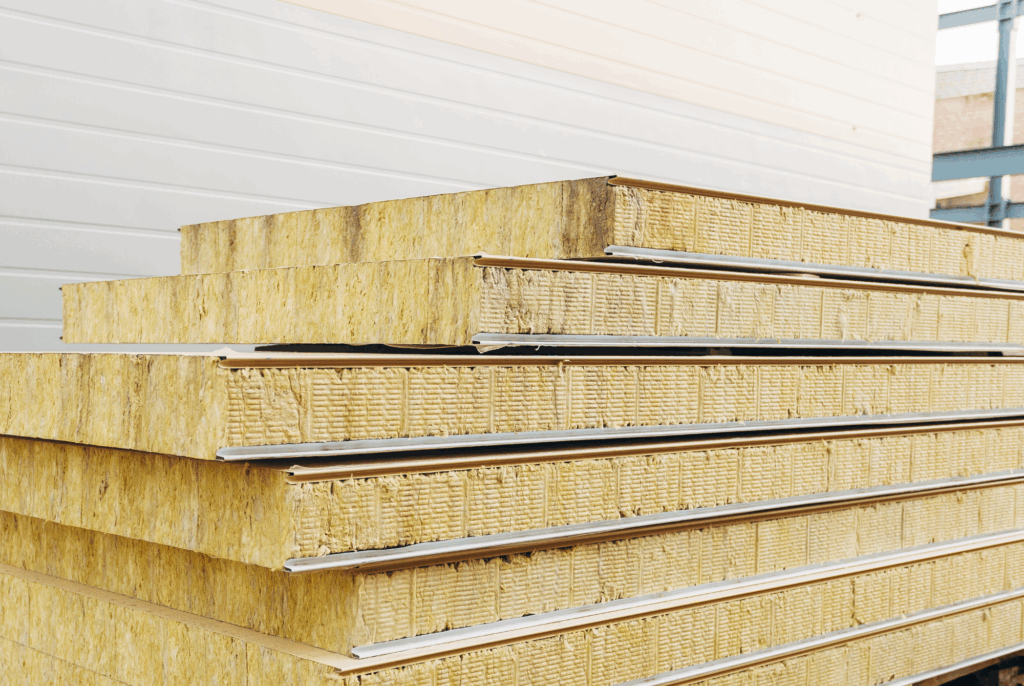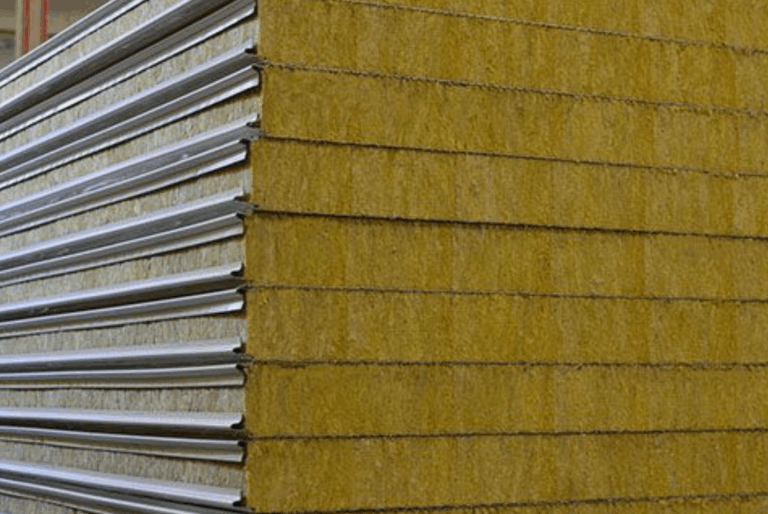Mineral wool is one of the most commonly used materials for thermal and acoustic insulation. As a mineral-based compound, it stands out for its low thermal conductivity and high heat resistance. The porous structure of this wool also provides excellent sound insulation properties.
Mineral wool panels offer comprehensive solutions by providing thermal comfort, energy efficiency, and safety in industrial and civil construction projects.
The manufacturing of mineral wool involves melting and spinning processes that produce strong and flexible fibers.
The raw material used is either smelting slag or volcanic-origin basalt rock, which is melted at high temperatures and then spun and drawn into fibers. These fibers are bonded with special resins to form blankets, panels, or rolls.
Mineral wool is available in various formats tailored to its wide range of applications, such as rolls, blankets, or integrated into the insulating core of a sandwich panel. Within the family of sandwich construction elements, mineral wool is incorporated into panels for roofs and façades—whether for industrial buildings, public works, or civil projects—as well as for interior partitions and different types of enclosures requiring thermal and acoustic insulation.
This Material Is Known For:
• Fire resistance: It is non-combustible (Class A1), capable of withstanding temperatures over 1000 °C without melting or spreading flames.
• Thermal insulation properties: With low thermal conductivity (0.035 – 0.045 W/m·K), it is ideal for maintaining stable indoor temperatures.
• Water repellency: It repels liquid water while allowing water vapor to diffuse, preventing condensation.
• Dimensional stability: It does not deform or shrink over time or due to temperature changes, ensuring long-lasting durability without loss of properties.
• Acoustic insulation: Its porous and fibrous structure effectively absorbs sound, making it an excellent acoustic insulator.
• Sustainability: It is made from natural raw materials and often contains recycled content, in addition to improving the energy efficiency of buildings.
________________________________________
What Are the Qualities of This Material?
Porous materials, like mineral wool, have natural insulating properties due to the air trapped inside, which is a poor conductor of thermal and sound energy.
An envelope insulated with rock wool panels stands out for its ability to minimize thermal exchange with the external environment.
In other words, buildings insulated with mineral wool maintain a stable indoor temperature by preventing heat from escaping in winter and warm air from entering in summer—reducing the need for energy-intensive heating and cooling.
• Mineral Wool as an Acoustic Insulator:
The porous structure of mineral wool also absorbs and dissipates sound waves, making it an ideal option for reducing noise transmission between spaces—such as partition walls, ceilings, machinery enclosures, and more. For this reason, it is widely used in applications requiring noise control, including recording studios, offices, and homes located near noisy areas.
When sound waves strike mineral wool, they penetrate its porous structure and encounter a network of interconnected passages and cavities, which triggers two key phenomena:
On one hand, sound waves are reflected and scattered as they bounce off the panel’s internal structure, reducing part of their energy. On the other hand, another portion of that energy is dissipated as the air molecules inside the wool begin to vibrate and rub against each other, which lowers the sound intensity.
This combination of absorption and resistance to sound propagation makes rock wool panels a popular choice in applications where creating quieter and more comfortable environments is a priority—such as homes, factories, recording studios, cinemas, offices, and more.
For more information and a variety of products, visit: Acoustic noise barriers – McMillan Insulated Panels
Mineral Wool in Fire Protection Systems
Due to its mineral composition and high melting point, mineral wool acts as a barrier against high temperatures and slows the spread of fire.
Essentially, rock wool provides extra time for the evacuation of facilities affected by such incidents by acting as a barrier, preventing fire from spreading, and helping to avoid premature structural collapse.
These characteristics make it an essential material in passive fire protection systems. When exposed to fire, it does not emit smoke or flaming droplets, effectively helping to stop fire propagation.
Flexible rock wool blankets can be used to wrap structural elements, cover ducts, or be installed in the form of high-density, self-supporting rock wool panels treated with intumescent coating (which expands when exposed to heat, reducing density and limiting heat transmission).
Explore our wide range of fire-resistant insulating panels at Products Product Template
• Mineral Wool Roof Panels
Mineral wool roofs are very durable and offer a long service life. Thanks to their resistance to moisture, rot, and damage caused by insects or fungi, they maintain their structural integrity for many years. This reduces the need for frequent replacement and contributes to long-term savings in maintenance costs.
Also mineral wool roofs provide excellent thermal insulation. Their porous structure and ability to retain the air trapped inside help to minimize heat transfer, keeping a more stable temperature inside the buildings. This allows for better temperature control, reduces the need for excessive heating or cooling systems, and ultimately helps to reduce energy costs.
• Installation
Mineral wool sandwich panels are installed simply and efficiently using basic tools—no mortar, water consumption, or specialized labor is required.
The dry assembly of rock wool sandwich panels is more akin to shipbuilding than traditional masonry, allowing for fast execution and significant cost savings Material waste is minimal, as are the labor hours needed to complete the installation and make the building operational.
In conclusion, mineral wool is a high-performance insulating material that stands out for its fire resistance, excellent thermal and acoustic performance, as well as its durability and resistance to moisture. These properties make it an especially suitable choice for the production of insulating panels—particularly for roofs and façades—where high standards of safety, energy efficiency, and indoor comfort are required.
Its mineral structure, combined with easy and sustainable installation, allows for significant improvements in building performance in both industrial and residential settings. Thanks to its versatility and reliability, rock wool remains one of the most comprehensive and secure solutions in the field of technical and construction insulation.
Contact our experts and feel free to ask any questions about insulating panels or the properties and characteristics of materials like mineral wool Contact





